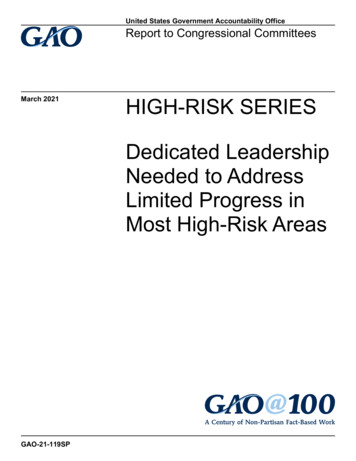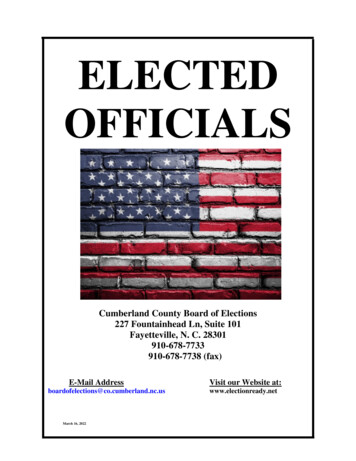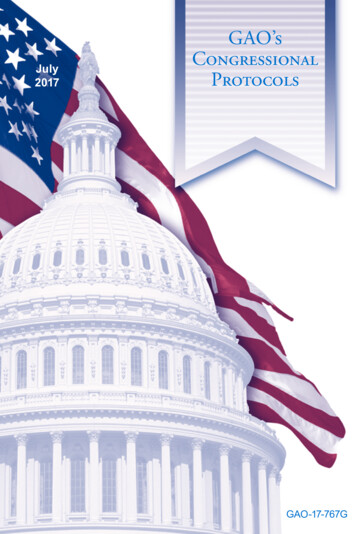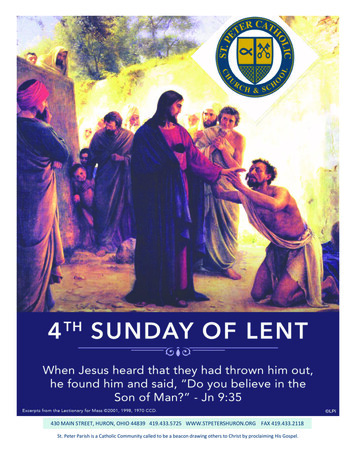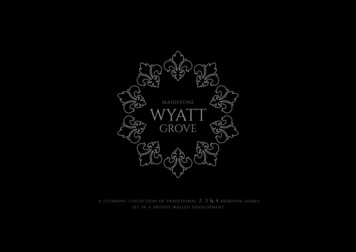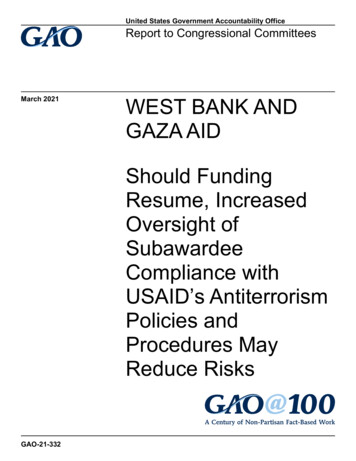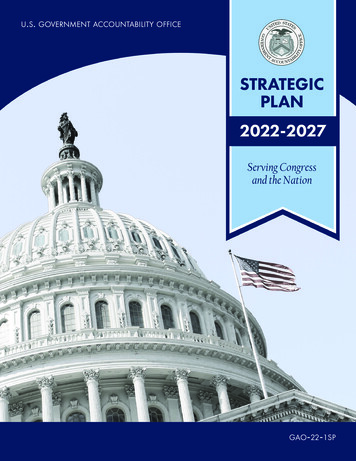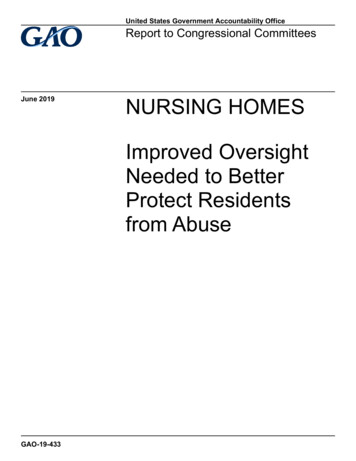
Transcription
United States Government Accountability OfficeReport to Congressional CommitteesJune 2019NURSING HOMESImproved OversightNeeded to BetterProtect Residentsfrom AbuseGAO-19-433
June 2019NURSING HOMESImproved Oversight Needed to Better ProtectResidents from AbuseHighlights of GAO-19-433, a report tocongressional committeesWhy GAO Did This StudyWhat GAO FoundNursing homes provide care to about1.4 million nursing home residents—avulnerable population of elderly anddisabled individuals. CMS, an agencywithin the Department of Health andHuman Services (HHS), definesstandards nursing homes must meet toparticipate in the Medicare andMedicaid programs.The Centers for Medicare & Medicaid Services (CMS) is responsible for ensuringnursing homes meet federal quality standards, including that residents are freefrom abuse. CMS enters into agreements with state survey agencies to conductsurveys of the state’s homes and to investigate complaints and incidents. GAOanalysis of CMS data found that, while relatively rare, abuse deficiencies cited innursing homes more than doubled, increasing from 430 in 2013 to 875 in 2017,with the largest increase in severe cases. GAO also reviewed a representativesample of abuse deficiency narratives from 2016 through 2017. Physical andmental/verbal abuse occurred most often in nursing homes, followed by sexualabuse, and staff were more often the perpetrators of the abuse deficienciescited. CMS cannot readily access information on abuse or perpetrator type in itsdata and, therefore, lacks key information critical to taking appropriate actions.GAO was asked to review abuse ofresidents in nursing homes. Amongother objectives, this report: (1)determines the trends and types ofabuse in recent years, and (2)evaluates CMS oversight intended toensure residents are free from abuse.GAO reviewed CMS’s policies,analyzed CMS data on abusedeficiencies from 2013 through 2017,the most recent data at the time of ourreview, and interviewed officials fromCMS and state survey agencies in fivestates, as well as other keystakeholders in those states such asombudsmen and law enforcementofficials. The states were selected forvariation in factors such as number ofnursing homes and role of other stateagencies in abuse investigations.What GAO RecommendsGAO is making six recommendations,including that CMS: require statesurvey agencies to submit data onabuse and perpetrator type; requirestate survey agencies to immediatelyrefer to law enforcement any suspicionof a crime; and develop guidance onwhat abuse information nursing homesshould self-report. HHS concurred withall of GAO’s recommendations andidentified actions it will take toimplement them.View GAO-19-433. For more information,contact John Dicken at (202) 512-7114 ordickenj@gao.gov.GAO Analysis of a Representative Sample of CMS Nursing Home Abuse DeficiencyNarratives, 2016-2017Note: Percentages do not add to 100 because some narratives had multiple types of abuse, weremissing or incomplete, or were not consistent with CMS’s definition of abuse.GAO also found gaps in CMS oversight, including: Gaps in CMS processes that can result in delayed and missed referrals.Federal law requires nursing home staff to immediately report to lawenforcement and the state survey agency reasonable suspicions of a crimethat results in serious bodily injury to a resident. However, there is noequivalent requirement that the state survey agency make a timely referralfor complaints it receives directly or through surveys it conducts. CMS alsodoes not conduct oversight to ensure that state survey agencies are correctlyreferring abuse cases to law enforcement.Insufficient information collected on facility-reported incidents. CMShas not issued guidance on what nursing homes should include when theyself-report abuse incidents to the state survey agencies. Officials from all ofthe state survey agencies in GAO’s review said the facility-reported incidentscan lack information needed to prioritize investigations and may result instate survey agencies not responding as quickly as needed.United States Government Accountability Office
ContentsLetter1BackgroundMore Abuse Deficiencies Were Cited in Nursing Homes from 2013through 2017; Physical and Mental/Verbal Abuse and StaffPerpetrators Were Most CommonStakeholders Identified Resident Characteristics and StaffingInadequacies as Risk Factors for Abuse, and Underreporting asamong the Challenges to Investigating AbuseCMS’s Ability to Ensure Nursing Home Residents Are Free fromAbuse May Be Limited by Gaps in OversightConclusionsRecommendations for Executive ActionAgency Comments35424243Additional Detail on Analysis of Centers for Medicare & MedicaidServices’ (CMS) Data45Appendix IITrends in Abuse-Related Deficiencies51Appendix IIIState Information on Abuse Deficiencies56Appendix IVComments from the Department of Health and Human Services60Appendix VGAO Contact and Staff Acknowledgments65Appendix I71428TablesTable 1: Centers for Medicare & Medicaid Services’ (CMS)Alphabetical Scope and Severity Categories for NursingHome DeficienciesTable 2: Characteristics of Nursing Homes with Multiple Years ofAbuse Deficiencies, a Single Year of Abuse Deficiencies,or No Abuse Deficiencies, 2013 through 2017Page i1023GAO-19-433 Nursing Home Resident Abuse
Table 3: Examples from a Representative Sample of NursingHome Abuse Deficiency Narratives, 2016-2017Table 4: Risk Factors for Nursing Home Abuse Identified byStakeholdersTable 5: Key Challenges for Abuse Investigations Identified byStakeholdersTable 6: Key Gaps in Centers for Medicare and MedicaidServices’ (CMS) Process for ReferralsTable 7: Centers for Medicare & Medicaid Services’ (CMS) Abuseand Perpetrator Type DefinitionsTable 8: Abuse Deficiencies Cited, by State, 2013 and 2017Table 9: Nursing Homes with Abuse Deficiencies Cited inConsecutive Years, by State, 2013 through 201727283338495658FiguresFigure 1: Primary Methods Used by State Survey Agencies toAssess Whether Nursing Homes Are Meeting FederalStandardsFigure 2: Severity of Cited Abuse Deficiencies, 2013 through 2017Figure 3: Type of Survey or Investigation Used to Identify AbuseDeficiencies and All Types of Deficiencies, 2013 through2017Figure 4: Types of Implemented Enforcement Actions for AbuseDeficiencies, 2013 through 2017Figure 5: Nursing Homes with Abuse Deficiencies Cited in MultipleYears, 2013 through 2017Figure 6: Representative Sample of Nursing Home AbuseDeficiency Narratives, by Abuse Type and PerpetratorType, 2016 through 2017Figure 7: Abuse-Related Deficiencies Cited, by Severity, 2013through 2017Figure 8: Source of Abuse Deficiencies, Abuse-RelatedDeficiencies, and All Types of Deficiencies, 2013 and2017Page ii1115172022265355GAO-19-433 Nursing Home Resident Abuse
AbbreviationsCMSHHSOIGMFCUCenters for Medicare & Medicaid ServicesDepartment of Health and Human ServicesOffice of Inspector GeneralMedicaid Fraud Control UnitThis is a work of the U.S. government and is not subject to copyright protection in theUnited States. The published product may be reproduced and distributed in its entiretywithout further permission from GAO. However, because this work may containcopyrighted images or other material, permission from the copyright holder may benecessary if you wish to reproduce this material separately.Page iiiGAO-19-433 Nursing Home Resident Abuse
Letter441 G St. N.W.Washington, DC 20548June 13, 2019The Honorable Chuck GrassleyChairmanThe Honorable Ron WydenRanking MemberCommittee on FinanceUnited States SenateThe Honorable Rob PortmanChairmanThe Honorable Thomas CarperRanking MemberPermanent Subcommittee on InvestigationsCommittee on Homeland Security and Governmental AffairsUnited States SenateNationwide, more than 15,500 nursing homes participating in theMedicare and Medicaid programs provide care to about 1.4 million elderlyor disabled nursing home residents. These residents often have physicaland cognitive limitations that can make them particularly vulnerable toabuse. Abuse of nursing home residents can occur in many forms—including physical, mental, verbal, and sexual—and can be committed bystaff, residents, or others in the nursing home. Little is known about thefull scope of nursing home abuse, as incidents of abuse may beunderreported. 1 Any incident of abuse is a serious occurrence and couldresult in potentially devastating consequences for residents, includinglasting mental anguish, serious injury, or death.Federal law mandates that nursing homes receiving Medicare andMedicaid payments must ensure that residents are free from abuse. Tohelp ensure this, the Centers for Medicare & Medicaid Services (CMS),an agency within the Department of Health and Human Services (HHS),defines the quality standards that nursing homes must meet in order to1C. Hawes, Elder Abuse in Residential Long-Term Care Settings: What is Known andWhat Information is Needed? National Research Council of the National Academies,Panel to Review Risk and Prevalence of Elder Abuse and Neglect. (Washington, D.C.:2003).Page 1GAO-19-433 Nursing Home Resident Abuse
participate in the Medicare and Medicaid programs. 2 To monitorcompliance with these standards, CMS enters into agreements withagencies in each state government—known as state survey agencies—and oversees the work the state survey agencies do. 3 This work includesconducting required evaluations—referred to as standard surveys—approximately once each year of all nursing homes in a state thatparticipate in the Medicare or Medicaid programs, as well as investigatingboth complaints from the public and facility-reported incidents regardingresident care or safety. 4 When a state survey agency finds a nursinghome out of compliance with a federal standard, the home receives adeficiency citation, also known as a deficiency.In addition to state survey agencies, other state-based agencies arecharged with protecting nursing home residents from abuse. Theseagencies’ roles, missions, and standards of evidence for determiningwhether or not abuse occurred can vary by state. For example, AdultProtective Services may also help ensure nursing home residents receive2CMS defines abuse in its guidance, the State Operations Manual (dated November 22,2017), as: “The willful infliction of injury, unreasonable confinement, intimidation, orpunishment with resulting physical harm, pain or mental anguish. Abuse also includes thedeprivation by an individual, including a caretaker, of goods or services that are necessaryto attain or maintain physical, mental, and psychosocial well-being.” This report addressesphysical abuse, mental and verbal abuse—which we refer to as “mental/verbal abuse”—and sexual abuse but does not address other forms of abuse, such as financial abuse orneglect.Medicare, the federal health insurance program for people age 65 and older, individualsunder age 65 with certain disabilities, and individuals diagnosed with end-stage renaldisease, covers some short-term skilled nursing and rehabilitative care for beneficiariesfollowing an acute care hospital stay. Medicaid, a joint federal-state health program forlow-income and medically needy individuals, is the nation’s primary payer of long-termservices and supports for children and adults with disabilities and aged individuals.3Survey agencies are frequently housed in the human services department of stategovernments and may have different names in different states.4By law, every nursing home receiving Medicare or Medicaid payment must undergo astandard survey during which teams of state surveyors conduct a comprehensive on-siteevaluation of compliance with federal quality standards. These surveys must occur at leastonce every fifteen months, with a statewide average interval for surveys not to exceed 12months. 42 U.S.C. §§ 1395i-3(g)(1)(A), (g)(2)(A)(iii), 1396r(g)(1)(A), (g)(2)(A)(iii).State survey agencies are also required to investigate allegations of neglect and abuse innursing homes in response to complaints and facility-reported incidents filed with statesurvey agencies. 42 U.S.C. §§ 1395i-3(g)(1)(C), 1396r(g)(1)(C). During an investigation,state surveyors evaluate the nursing home’s compliance with a specific federal qualitystandard.Page 2GAO-19-433 Nursing Home Resident Abuse
quality care in a safe environment by investigating allegations of abuse. 5Law enforcement can also play a role in protecting nursing homeresidents from abuse and, in addition, Medicaid Fraud Control Units(MFCU) in each state are tasked with investigating and prosecuting avariety of health care-related crimes.We have previously reported on problems in nursing home quality,including problems protecting residents from abuse and weaknesses inCMS’s oversight. For example, in multiple reports dating back to 1998, wehave identified weaknesses in federal and state activities designed tocorrect quality problems in nursing homes. Specifically, in a 2002 report,we found that CMS needed to do more to protect nursing home residentsfrom abuse and made five recommendations to help CMS facilitate thereporting, investigation, and prevention of abuse in nursing homes. 6 Morerecently, in April 2019 we reported that CMS had failed to address gaps infederal oversight of nursing home abuse investigations in Oregon thatpersisted for at least 15 years until the Oregon state survey agencychanged its practices in October 2018. 7 Further, a 2017 HHS Office of theInspector General (OIG) report found that CMS does not have adequateprocedures in place to ensure incidents of potential abuse in nursinghomes are identified and reported. 8 In addition, news reports have5Long-term care ombudsmen and Adult Protective Services may investigate and resolvecomplaints involving residents of nursing homes. In some states, Adult Protective Servicesmay not have jurisdiction in nursing homes. While Adult Protective Services operates atthe state level, some states receive federal funding for part or all of their programs.6One of our recommendations was implemented—that CMS clarify the definition of abuseand otherwise ensure that states apply that definition consistently and appropriately. WhileCMS generally agreed with our recommendations, the other four recommendations wereclosed as not implemented. See GAO, Nursing Homes: More Can Be Done to ProtectResidents from Abuse, GAO-02-312, (Washington, D.C.: March 1, 2002).7GAO, Management Report: CMS Needs to Address Gaps in Federal Oversight ofNursing Home Abuse Investigations That Persisted in Oregon for at Least 15 Years,GAO-19-313R, (Washington, D.C.: Apr. 15, 2019).8See Daniel R. Levinson, OIG, HHS, memorandum to Seema Verma, Administrator, CMS,Early Alert: The Centers for Medicare & Medicaid Services Has Inadequate ProceduresTo Ensure That Incidents of Potential Abuse or Neglect at Skilled Nursing Facilities AreIdentified and Reported in Accordance With Applicable Requirements, A-01-17-00504(Washington, D.C.: August 24, 2017).Page 3GAO-19-433 Nursing Home Resident Abuse
described concerning examples of incidents where nursing homeresidents were abused. 9You asked us to review abuse of nursing home residents including,among other issues, what CMS data reveal about the prevalence ofabuse and the extent to which CMS oversees nursing homes. In thisreport, we:1. determine the trends and types of abuse occurring in nursing homesin recent years,2. describe the risk factors for abuse and challenges facing stakeholderagencies involved in investigating abuse in nursing homes, and3. evaluate CMS oversight intended to ensure that nursing homeresidents are free from abuse.To determine the trends and types of abuse occurring in nursing homes inrecent years, we reviewed CMS guidance and analyzed CMS data from2013 through 2017, which represented the most recent data for a 5-yearperiod at the time of our review. First, we reviewed the CMS StateOperations Manual in effect during our period of review to determine thefederal standards and associated deficiency codes related to residentabuse. 10 We focused our analysis on the deficiency code to be used bystate surveyors when a nursing home fails to keep a resident free fromabuse, which encompasses mental/verbal, sexual, or physical abuse. 119For example, see Blake Ellis and Melanie Hicken, “Sick, Dying, and Raped in America’sNursing Homes,” CNN, February 22, 2017. Also see Chris Serres, “Left to Suffer: A FivePart Series,” Minneapolis Star Tribune, November 12, 2017.10Specifically, we reviewed Appendix PP of the State Operations Manual because it is thesection that provides guidance to state surveyors about determining compliance withfederal quality standards and their associated deficiency codes. There were multipleupdates to Appendix PP of the State Operations Manual during the period of our review(January 1, 2013, through November 27, 2017). Specifically, there were eight updates tothe appendix during the 5-year period, but none of these changed the abuse deficiencycitation codes used by state surveyors. Therefore, we used the March 8, 2017, version ofthe Appendix PP—the most recent version during our period of review—when determiningwhich deficiency codes to analyze for this report. CMS, State Operations Manual,Appendix PP—Guidance to Surveyors for Long Term Care Facilities. (March 8, 2017).CMS restructured its deficiency code system beginning on November 28, 2017, and, dueto these coding changes, we did not analyze CMS data cited by surveyors after theimplementation of that change.11For the purposes of this report, we refer to mental and verbal abuse as “mental/verbalabuse.” Over the period of time examined in our review, CMS’s abuse deficiency codealso included involuntary seclusion.Page 4GAO-19-433 Nursing Home Resident Abuse
We analyzed data provided by CMS to identify the number and severity ofabuse deficiencies cited by surveyors in all 50 states and WashingtonD.C. between 2013 and 2017. We then tracked (1) whether these abusedeficiencies originated from a standard survey, complaint investigation, orfacility-reported incident investigation and (2) the enforcement actionsassociated with these abuse deficiencies. Furthermore, we determinedthe number of nursing homes that had one or more abuse deficienciesfrom 2013 through 2017, as well as the homes with repeated abusedeficiencies in multiple years and the characteristics of those homes. 12Finally, because abuse and perpetrator type are not readily identifiable inCMS’s data, we identified this information by reviewing a randomlyselected representative sample of 400 abuse deficiency narratives writtenby state surveyors from 2016 through 2017 that describe thesubstantiated abuse. Specifically, two separate reviewers independentlyanalyzed the text of each narrative and determined if the abuse wasphysical, mental/verbal, or sexual and whether the perpetrators werestaff, residents, or others based on narrative descriptions written by statesurveyors. 13 Any disagreements between the two reviewers wereresolved by a third independent reviewer. We assessed the reliability ofeach of the datasets by checking for missing values and obvious errorsand discussing them with CMS officials who were knowledgeable aboutthe data. In the course of this assessment, we found some datalimitations. Specifically, CMS officials told us that some state surveyagencies may not have entered all facility-reported incidents into the CMSdatabase while other state survey agencies did. 14 In a recent 2019 report,we also found that the Oregon state survey agency was not entering allabuse-related complaints or facility-reported incidents into the CMSdatabase—a problem that could exist in other states. 15 In addition, CMSofficials told us that it is possible there are additional incidents that may12For the purposes of this report, we include Washington, D.C. when we refer to data forstates.13We analyzed the abuse deficiency narratives according to CMS’s definitions in its StateOperations Manual. CMS, State Operations Manual, Appendix PP—Guidance toSurveyors for Long Term Care Facilities. (November 22, 2017).14CMS guidance requires state survey agencies to enter facility-reported incidents into theCMS database that require a federal, on-site survey.15See GAO-19-313R. Further, our 2011 report noted CMS’s concerns regarding theunderreporting of complaints from state survey agencies. See GAO, Nursing Homes:More Reliable Data and Consistent Guidance Would Improve CMS Oversight of StateComplaint Investigations, GAO-11-280, (Washington, D.C.: Apr. 7, 2011).Page 5GAO-19-433 Nursing Home Resident Abuse
not have been represented in the abuse deficiency data during the periodof our review. Specifically, CMS officials noted that some incidentsresulting from resident altercations—particularly those that do not show awillful intent to harm—may not be cited as an abuse deficiency by somestate survey agencies. We therefore consider the number of abusedeficiencies that resulted from complaints or facility-reported incidents tobe a conservative estimate. After reviewing the possible limitations ofthese data, we determined the data were sufficiently reliable for thepurposes of this reporting objective. (See app. I for additional details onthe scope and methodology of our data analyses.)To describe the risk factors for abuse and challenges facing stakeholderagencies involved in investigating abuse in nursing homes, weinterviewed officials from a non-generalizable sample of five state surveyagencies—Delaware, Georgia, Ohio, Oregon, and Virginia. We selectedthese states for variation in geography, whether the states’ AdultProtective Services has oversight over nursing home residents, thenumber of nursing homes in each state, CMS regional oversight, andcongressional interest. In addition to speaking to officials from statesurvey agencies, we interviewed other stakeholders in these states,including officials from each state’s long-term care ombudsmen, lawenforcement, MFCUs, and, when appropriate, Adult Protective Services. 16We also visited nursing homes and spoke to administrators and clinicalstaff in each state. We selected these nursing homes to obtain variation infactors such as bed count and profit or not-for-profit status. We askedstakeholders to describe the risk factors for abuse and the challengesinvolved in investigating abuse in nursing homes. In addition, weinterviewed officials from national organizations with knowledge ofnursing home abuse issues including the American Health CareAssociation, National Consumer Voice, and the National Adult ProtectiveServices Association to learn more about the risk factors for abuse andthe challenges facing stakeholders involved in investigating abuse.To evaluate CMS oversight intended to ensure that nursing homeresidents are free from abuse, we reviewed relevant federal laws andCMS guidance, such as the State Operations Manual, that establishesCMS and state survey agency oversight responsibilities for nursinghomes. We also interviewed officials at the CMS central office, the CMS16We only interviewed officials from Adult Protective Services in Oregon and Virginiabecause, in those states, Adult Protective Services had nursing home oversight whereasin the other states in our review, it did not.Page 6GAO-19-433 Nursing Home Resident Abuse
regional offices that oversee the five state survey agencies in our review,and the five state survey agencies themselves. We assessed CMS’soversight activities in the context of the federal standards for internalcontrol related to information and communications and monitoring. 17We conducted this performance audit from October 2017 to June 2019 inaccordance with generally accepted government auditing standards.Those standards require that we plan and perform the audit to obtainsufficient, appropriate evidence to provide a reasonable basis for ourfindings and conclusions based on our audit objectives. We believe thatthe evidence obtained provides a reasonable basis for our findings andconclusions based on our audit objectives.BackgroundNursing homes are required to keep residents safe from harm, but whenabuse is alleged, a combination of federal, state, and local agencies—aswell as the nursing homes themselves—play a role in investigating.Federal Oversight ofNursing HomesFederal laws establish minimum requirements nursing homes must meetto participate in the Medicare and Medicaid programs, includingstandards for the quality of care. 18 These standards cover a variety ofcategories, such as resident rights, quality of care, and quality of life. In2016, CMS finalized a comprehensive update to its nursing homestandards to reflect new requirements and align requirements with current17GAO, Standards for Internal Control in the Federal Government. GAO-14-704G(Washington, D.C.: Sept. 10, 2014). Internal control is a process effected by an entity’soversight body, management, and other personnel that provides reasonable assurancethat the objectives of an entity will be achieved.18Titles XVIII and XIX of the Social Security Act, as amended, establish minimumrequirements nursing homes must meet to participate in the Medicare and Medicaidprograms, respectively.The Social Security Act and their implementing regulations use the terms “skilled nursingfacility” (Medicare) and “nursing facility” (Medicaid). For the purposes of this report, weuse the term nursing home to refer to both skilled nursing facilities and nursing facilities.Page 7GAO-19-433 Nursing Home Resident Abuse
clinical practices, among other things. The changes were implemented inthree phases, starting November 28, 2016. 19The federal government and the states share oversight responsibility forthe nation’s nursing homes, with specific activities occurring at thenational, regional, and state levels. CMS central office. At the national level, the CMS central officeoversees the federal standards nursing homes must meet toparticipate in the Medicare and Medicaid programs. Primarily throughits State Operations Manual, the office establishes the responsibilitiesof CMS’s regional offices and state survey agencies in ensuring thatfederal quality standards for nursing homes are met. CMS regional offices. CMS’s 10 regional offices oversee stateactivities and report back to the CMS central office the results of theirefforts. Specifically, regional offices use the State PerformanceStandards System to evaluate state surveyors’ performance onfactors such as the frequency and quality of state surveys. State survey agencies. Under agreement with CMS, a state surveyagency in each state assesses whether nursing homes meet CMS’sstandards, allowing them to participate in the Medicare and Medicaidprograms. State survey agencies assess nursing homes using (1)recurring standard surveys and (2) as-needed investigations. Standard surveys. State survey agencies are required by federallaw to perform unannounced, on-site standard surveys of everynursing home receiving Medicare or Medicaid payment at leastevery 15 months, with a statewide average frequency of every 12months. These surveys are a comprehensive assessment19Medicare and Medicaid Programs; Reform of Requirements for Long-Term CareFacilities, 81 Fed. Reg. 686888 (Oct. 4, 2016).Phase 1 (effective November 28, 2016)implemented most minor modifications to the existing nursing home regulations; phase 2(effective November 28, 2017) implemented new regulations and re-structured CMS’sdeficiency code system; and phase 3 (effective November 28, 2019) will implement theremaining requirements.Page 8GAO-19-433 Nursing Home Resident Abuse
designed to determine whether nursing homes are complying withMedicare and Medicaid quality standards. 20 Investigations. In addition to standard surveys, state surveyagencies are required by federal law to investigate (1) complaintssubmitted by residents, family members, friends, physicians, andnursing home staff; and (2) “facility-reported incidents,” includingincidents involving abuse of residents, that are self-reported by thenursing homes. State survey agencies review the informationprovided through these complaints and incidents and determine ifan on-site investigation is required. During this unannouncedinvestigation, the state surveyors assess available evidence todetermine whether the allegation can be substantiated. Theseinvestigations offer the state survey agency the opportunity toidentify and correct care problems in a more timely manner thanthrough the standard surveys.If a surveyor determines that a nursing home violated a federal standardduring a survey or investigation, then a deficiency code specific to thatstandard is cited. For instance, one deficiency code for abuse of residentsencompasses mental/verbal, sexual, or physical abuse; while a fewadditional deficiency codes encompass abuse-related issues, such as afailure by the nursing home to train staff on issues related to abuse. Citeddeficiencies are then classified into categories according to scope (thenumber of residents potentially affected) and severity (the potential for oroccurrence of harm to residents). (See table 1.) State survey agenciesare required to enter data about deficiencies into CMS’s survey database.For most deficiencies, the nursing home is required to prepare a plan ofcorrection, and, depending on the scope and severity of the deficiency,surveyors may re-visit the facility to ensure that the nursing home hasimplemented its plan and corrected the deficiency. In any instanceswhere surveyors substantiate the occurrence of resident abuse, the statesurvey agency is required to refer the case to three entities: 1) local law20On November 28, 2017, as a part of implementation phase 2, CMS rolled out a newsurvey system—which implemented our 2015 recommendation that CMS establishtimeframes for the development and implementation of a standardized survey systemacross all states. The new survey system was implemented simultaneously nationwide, sotha
abuse. Abuse of nursing home residents can occur in many forms— including physical, mental, verbal, and sexual—and can be committed by staff, residents, or others in the nursing home. Little is known about the full scope of nursing home abuse, as incidents of abuse may be underreported.
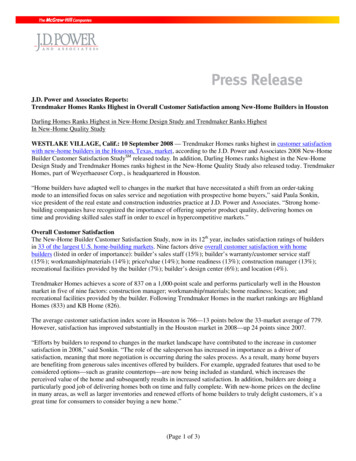
![Table 1 [ IMG1]: Codes to Identify Neuroimaging in Administrative .](/img/42/chipra-0198-tables1-9.jpg)
